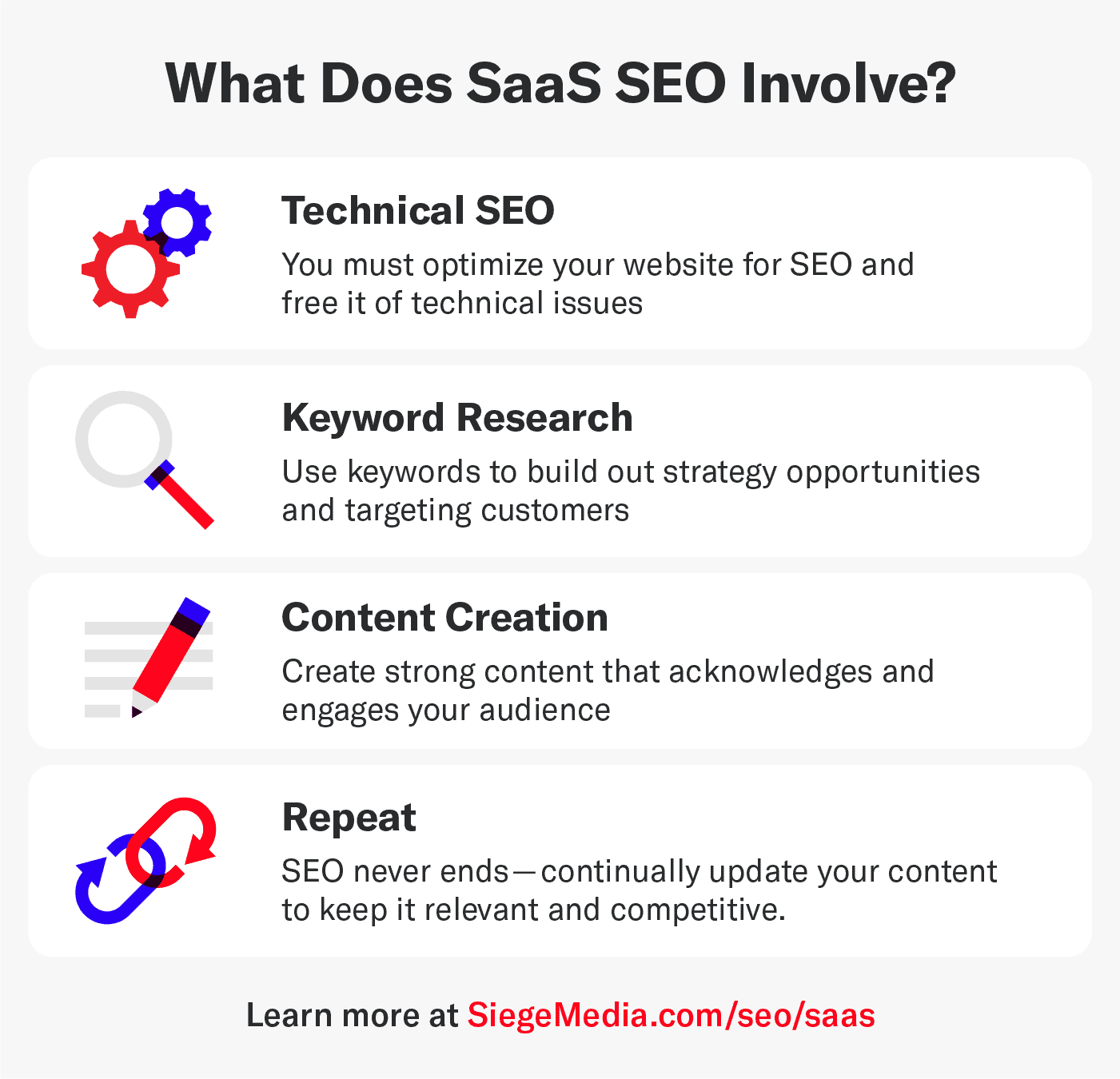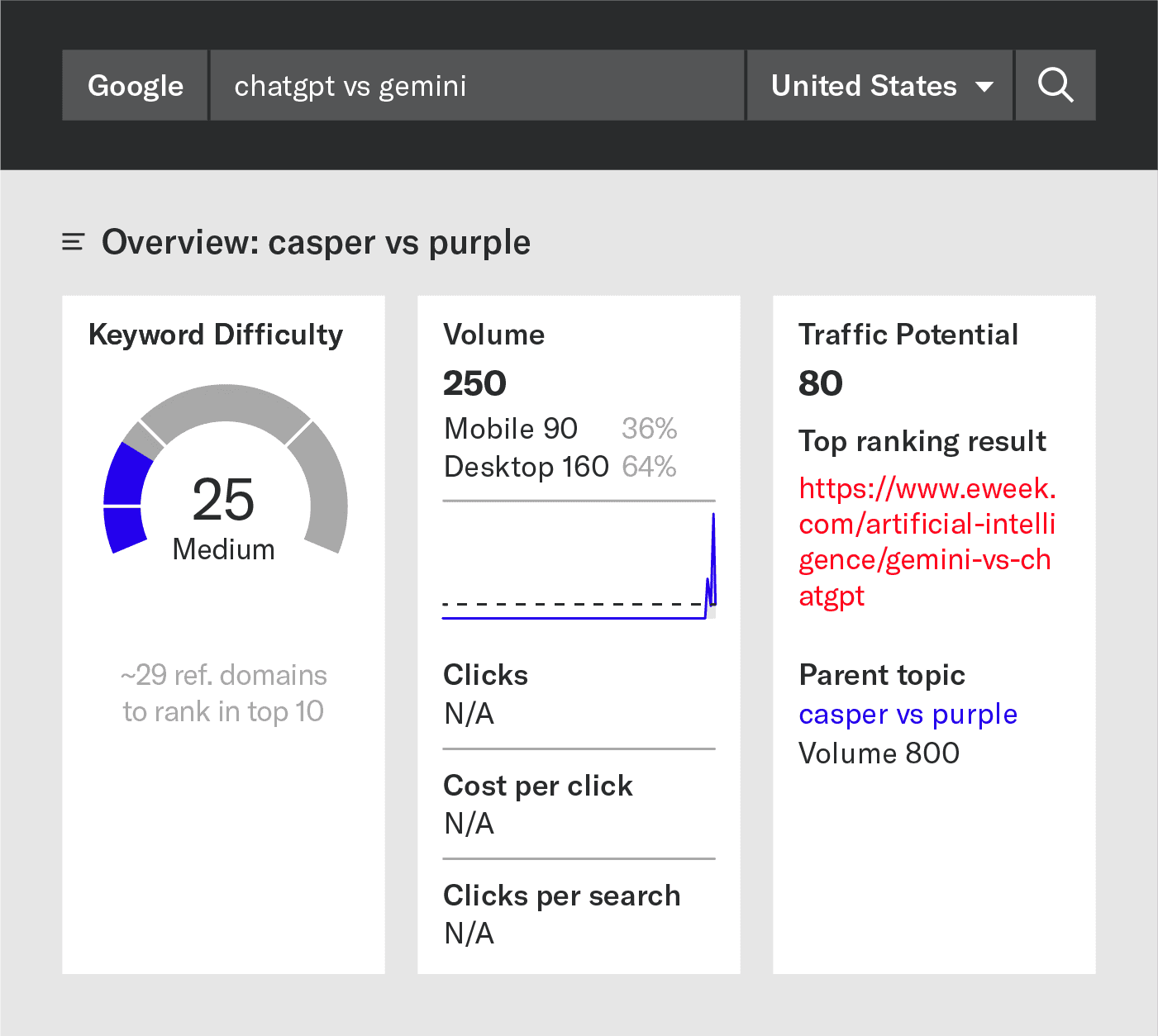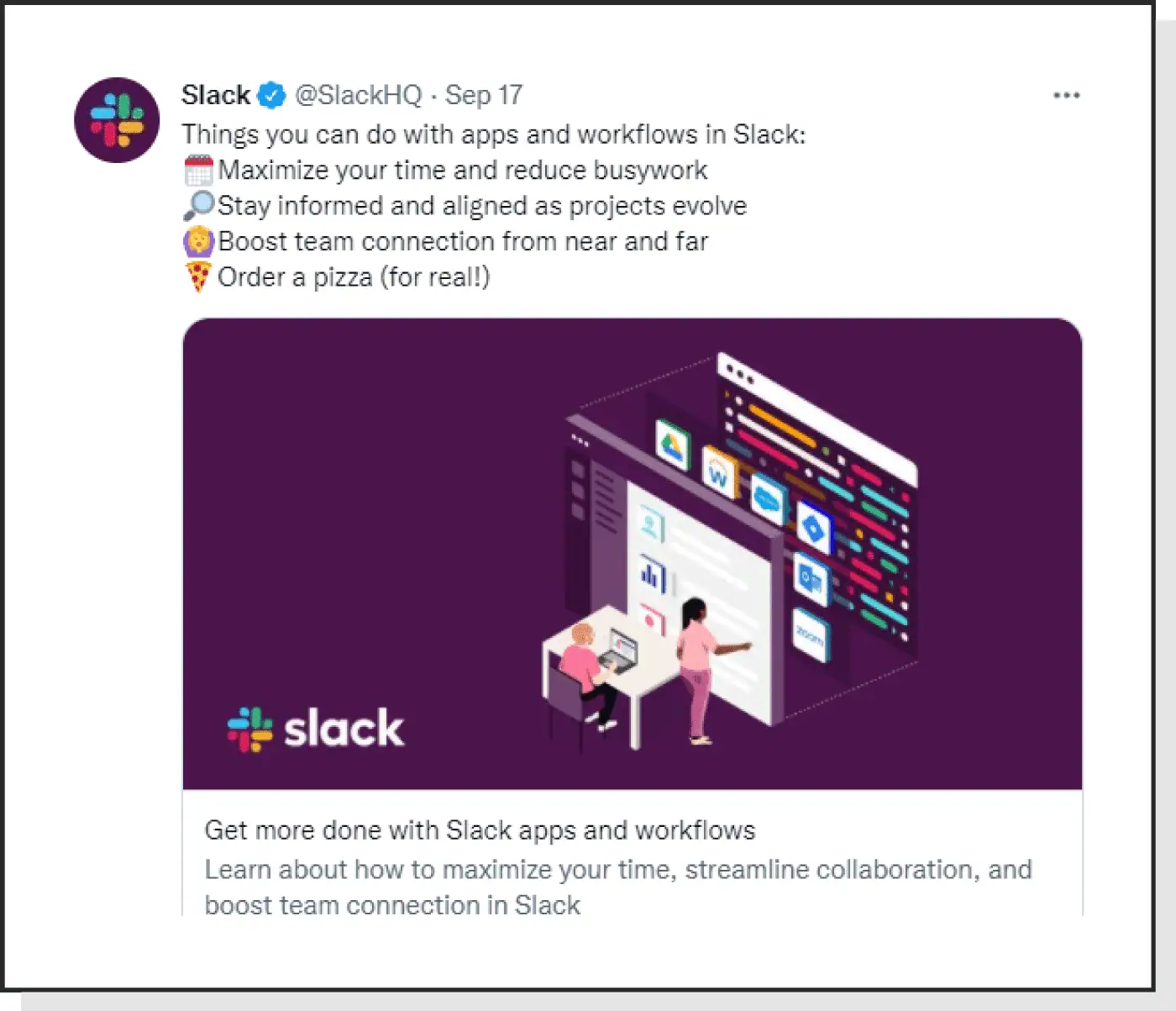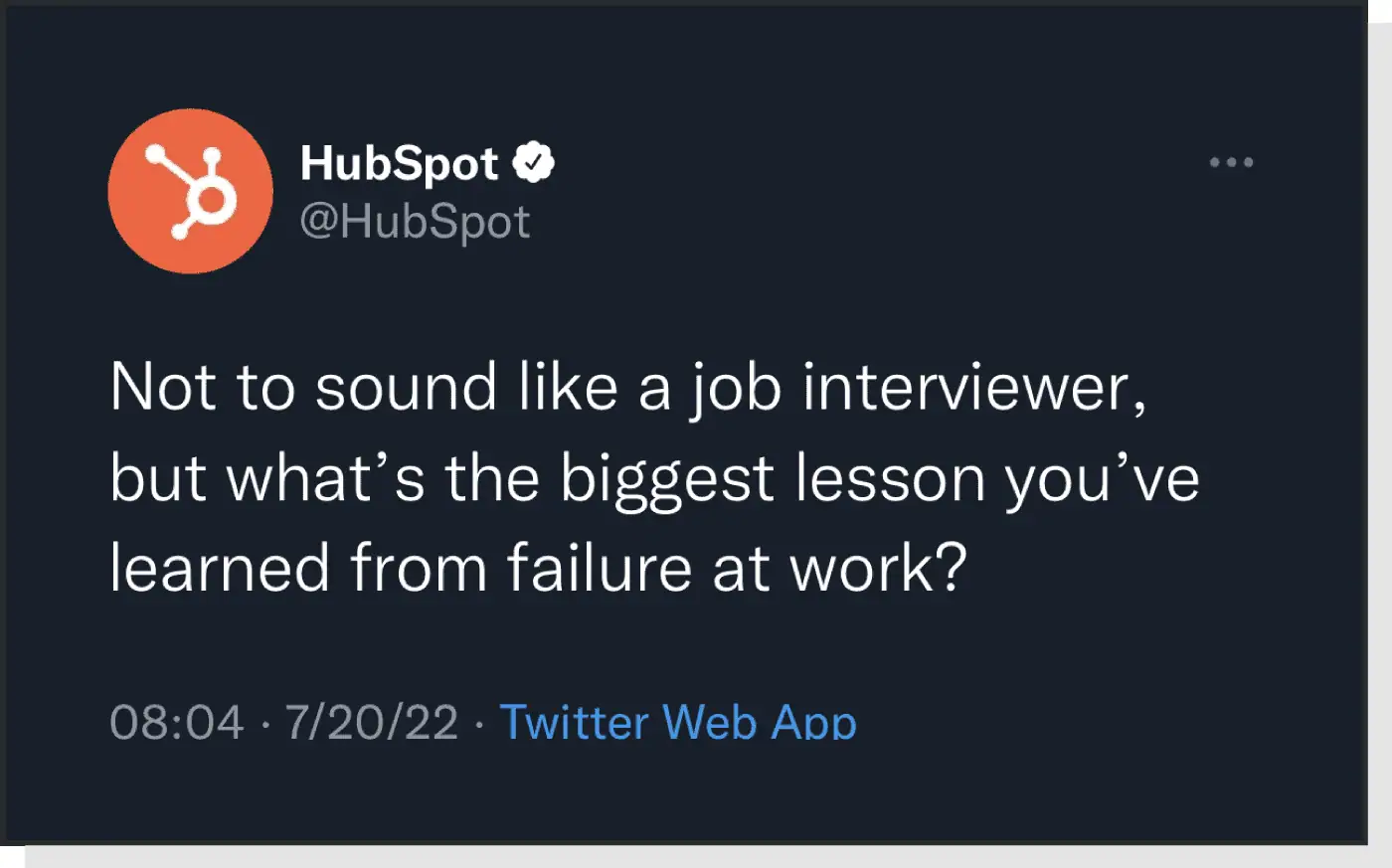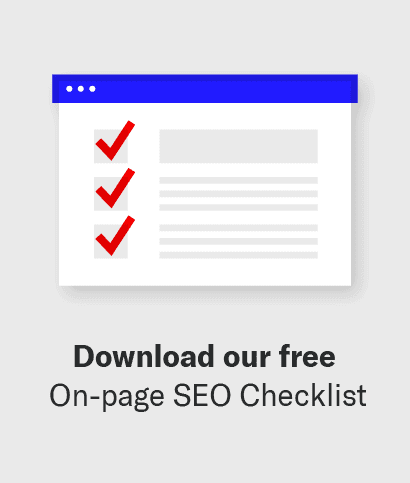Some industries are simply more competitive than others — SaaS is one of them. To have a leg up on the competition, a comprehensive SEO strategy might be exactly what you need.
We get it. Investing resources into SEO can be daunting, but beware of cutting corners.
Some SaaS companies will acquire customers through paid advertising. Although some businesses may find short-term success, it’s costly — and if you turn it off, it stops new customers from coming into the pipeline.
On the other hand, SEO for SaaS companies is key to reducing cost per acquisition due to its organic impact. Ultimately, it helps convert from other channels, so setting a solid SaaS SEO strategy is more sustainable in the long term.
Take CleverTap, a mobile marketing SaaS company, as an example.
Through our comprehensive content marketing and SEO strategy, Siege Media helped Zapier grow its organic traffic by 852%. The company saw a $6.1 million increase in its traffic value, with 126 Siege-generated pieces ranking within the top ten SERP results.
Yes, getting those results may seem intimidating at first, but luckily, you’ve come to the right place.
In this guide, we’ll cover what SEO is for SaaS companies, why it’s important, and the steps to implement a solid strategy or optimize an existing one that you may already have in place.
Table of contents:
- What Is SaaS SEO, and How Is It Different?
- Why SaaS SEO Is Important
- Understanding SaaS Keywords and the Buyers Funnel
- Creating a SaaS SEO Content Strategy in 7 Steps
- SaaS SEO in Action, Clear Examples
- Let a SaaS SEO Agency Kickstart Your Growth
What Is SaaS SEO, and How Is It Different?
First things first: SaaS SEO is not your typical SEO. It is the process of increasing organic traffic for software-as-a-service (SaaS) companies. It differs from industries like e-commerce and fintech because SaaS businesses rely heavily on organic search due to their buyer’s journey.
This means that within SaaS SEO, earning top rankings on search engines for relevant keywords within their niche or industry is paramount.
SaaS SEO is considered a long-term and holistic SEO approach that can continue to drive organic traffic long after content has been published.
Other strategies like pay-per-click marketing (PPC) can immediately place a company at the top of the SERP. However, if turned off, that visibility can quickly drop along with any traffic and revenue it was bringing in.
The bulk of SEO for SaaS companies typically involves posts that target prospects who are not at the bottom funnel of the buying stage but instead are:
- Individuals who know the software exists and are searching for more information: They may be aware a company like yours exists but are simply searching to see if it fits their needs.
- Searching specifically for your software: The searcher is familiar with your company and wants to learn more about what you offer.
- Nearing the purchase funnel: The searcher isn’t quite yet ready to pull the trigger but they’re researching pricing and/or who can give them the best deal.
- Top funnel and simply looking for content related to your software: These searches are not ready and aren’t looking for software like yours right now. However, they may be in your target audience in the future as they’re searching for content that aligns with your software/services.
SaaS SEO helps position your website in front of these searchers at various points in the buyer’s funnel through great content that will answer a user’s query and can naturally gain backlinks, improve rankings, and increase traffic — ultimately generating leads and customer conversions.
Why SaaS SEO Is Important
We’ve touched on how many SaaS companies lean heavily into performance marketing and paid media. There’s no doubt that harnessing the power of paid search has its benefits for SEO.
However, we can’t stress enough that PPC is expensive and a quick short-term solution with no actual value when results are deviated by the touch of a button, which is a common occurrence.
Developing a solid SEO strategy isn’t just about diversifying your customer acquisition methods.
SaaS companies need to invest in a solid SaaS content marketing strategy for several reasons. Keep on reading as we break it down.
Increase Your Website’s Growth
Well-performing and optimized SEO content can exponentially increase website traffic and can have a compounding effect when SaaS companies build up a robust content library.
For example, HubSpot and Pipedrive are two SaaS giants.
Both companies have a wealth of best-in-class content that not only ranks and drives significant traffic but targets various stages of the buyer’s funnel — this is key.
The more top-ranking content you create, the more traffic you’ll naturally drive month over month and year over year.
This allows you to create topic clusters without emptying your pockets (or topically related content based on a valuable set of keywords).
Reduce Your Cost Per Acquisition
Acquiring customers through paid media like PPC means that you’re paying for every click to your website.
Over time, as you run an optimized campaign, your cost per acquisition will only go up because you exhaust the audiences that are most likely to convert.
Content-driven SEO does just the opposite and can actually help reduce your cost per acquisition over time.
If it sounds too good to be true, don’t worry — there’s only one caveat.
Content-driven SEO takes time. SaaS companies looking for a quick strategy or quick results might find methods like PPC appealing as this can certainly help create those quick wins marketing teams are looking for.
Just be aware that paid search strategies are not known for holding up long term and don’t have quite the ROI that content marketing can offer.
Entice Customers From Different Channels
Because a good SaaS SEO strategy is undoubtedly a heavy investment in content creation, you’ll likely want to use this content as part of your email marketing and social media strategies to get the most bang for your buck.
Not to mention that if you’re creating backlinks through content promotion, you’ll be driving referral traffic.
SaaS companies like HubSpot, Zoom, Slack, and Adobe are great examples of companies that invest in their social media presence — particularly on X (formerly Twitter) — and do it with flair.
Understanding SaaS Keywords and the Buyer’s Funnel
Before you implement your strategy, SaaS SEO means you must understand how to conduct keyword research and build content that finds readers at the correct stage of their buyer’s journey.
Without this in mind, you risk losing them to a competitor.
Top Funnel Keywords
Top funnel keywords are those where potential buyers are searching for a solution to a problem they have while not even knowing your software/solution exists.
These keywords make up the vast majority of blog content and rarely convert.
The idea here is simply to introduce the prospect to your service and put you on their radar as a potential solution down the road as they do more research.
Mid Funnel Keywords
Middle-funnel keywords target topics where your prospect now knows about you or your competitors and starts doing in-depth research. At this stage, there’s intent to purchase, but typically not right away.
Keywords that align themselves well at this stage are products and feature landing pages.
Bottom Funnel Keywords
At this stage, the prospect is deciding between you and your competitor, which is why it’s important to target keywords around:
- Pricing
- Reviews
- Competitor comparison (“YOU” vs. “THEM”)
- Integrations
The bottom funnel stage is your most important stage, as it’s the last chance to convince prospects that you can help them solve the problems they’re facing instead of going with a competitor.
Creating a SaaS SEO Content Strategy in 7 Steps
A SaaS SEO strategy doesn’t need to be complicated. Still, it’s important to consider your long-term strategy—whether you’ll focus on a content-driven strategy or choose between SEO and PPC. There are some important steps that you’ll need to take if you plan to make it a successful one.
1. Define Your Audience and Their Problems
When it comes to SaaS SEO, identifying your target personas and their problems are where you need to start.
Remember, there are several stages of the buyer’s journey, and SEO is a long game, which is why understanding your target persona(s) is key to creating a strategy that puts your service directly in front of them when they’re conducting a search, while also making sure you get people who move through the various stages of the buyer’s funnel without dropping off.
Identifying Your Persona’s Problems
- Persona discovers a service while hunting to solve a problem they’re having.
- You identify these problems.
- Next, you build content around these problems that will help place your service in front of your target persona.
- In doing so, you direct your target persona to the solution (e.g. your service) to the problem they’re experiencing.
2. Build Out a Competitor Analysis
Analyzing your direct and indirect competitors’ SEO strategies is a key component of SaaS SEO. You should examine how they drive their organic traffic to build your strategy.
Chances are, if your competitor(s) are driving solid organic traffic, they probably have a good SEO and content marketing strategy in place. Mirroring their strategy while still finding ways to be unique is a good starting point.
Identify Your Competitors!
- Direct competitors: These are companies who do what you do. They may have different services or features but the overall premise of the business is the same and help potential customers solve the same problems.
- Indirect competitors: Those who help potential customers solve the same problem through a different approach. They don’t offer the same services or products.
Building out a comprehensive analysis (think content, analytics, brand awareness, etc.) of direct and indirect competitors’ SEO strategies and how they drive their site traffic will help you gather insights into their broader performance and what you should or shouldn’t focus on.
3. Don’t Forget the Technical SEO Factors
Although well-performing content is a huge component of any sound SEO strategy, technical SEO is still a factor. It doesn’t matter how much stellar content you create—if you don’t optimize your site for SEO, it won’t matter, and your site won’t rank.
Conducting a site audit can help:
- Identifying duplicate content.
- How many pages your site has indexed or no-indexed.
- If your site is suffering from technical issues, or if it’s just not optimized for SEO.
Fortunately, most SaaS websites aren’t complicated from a technical SEO standpoint, and an audit is relatively easy to complete.
4. Build a Strategy Around Keywords
Remember that list of problems you identified for your target personas?
Well, use that list to build out keyword opportunities.
Once you’ve created a solid list, turn to platforms like Ahrefs or SEMRush to identify which primary and long tail keywords are being searched the most.
At Siege, this is where the Keyword Opposition to Benefit (KOB) analysis comes into play.
A KOB Analysis is a strategic approach that compares keyword difficulty to what people are willing to spend on that content, and it’s a key component of helping you build your content strategy and project plan.
In a nutshell, the KOB analysis helps you:
- Find and pick “low-hanging fruit” keywords.
- Prioritize topics where our clients can rank quickly at each stage of the buyer funnel.
- Achieve a sizable ROI.
This is your brainstorming session where you’ll want to build out a content strategy around various top, mid, and bottom funnel keywords (remembering the goal is to push readers through the sales funnel).
5. Build Out Comparison Keywords
Chances are many of the broad, informational keywords that you’ll have brainstormed around in the stage above will speak to readers in the top funnel stages.
However, when a buyer nears the bottom funnel of the sales channel, they’ll compare two products or solutions (ideally, one of them is yours).
Essentially, comparison queries look like this:
[YOU] vs. [COMPETITOR]
Comparison keywords are powerful because they give you a chance to position yourself directly in front of a potential customer as they’re about to decide between your service or another, and then make the case that your service is the one they need to choose.
6. Standout Amongst Your Competitors
The goal should always be to blow your competitors’ content out of the water whenever possible.
Whether it’s a blog post with an infographic (which is great for manually driving links and user experience) or an interactive post (which has great passive link value), what you create should always outdo your competitors.
Here are some tips for writing SEO-friendly content:
- Shorter but more in-depth or concise information for SEO
- More visually appealing with videos, illustrations, or other images
- Easy to scan
- Build trust with E-E-A-T (Experience, Expertise, Authoritativeness, Trust)
- Write with empathy
- Use internal links
- Don’t forget SEO post structure and technical SEO
- Pique interest with APPB (Attention, Preview, Proof, Benefit)
APPB doesn’t have to follow any specific order, but ultimately, it helps sell your content to your readers.
- Preview: Give your readers insight into the rest of the post. For example, you could hook them with something like, “In this post, we’ll cover…”
- Proof: You’re the experts, so explain why. This is a good time to highlight your expertise in the industry through case studies, testimonials, reviews, etc.
- Benefit: Answer the question of how you’ll help them solve their problem and why they should care.
All these little details to differentiate yourself add up, even though it may feel like you’re creating similar content.
7. Promote Your Content and Earn Backlinks
Unless you have a low-competition keyword, your content will struggle to rank without backlinks.
This is why content promotion and earning backlinks through organic link building (like digital PR) or manual link building strategies (or a combination of both) are all part of a comprehensive approach to SaaS SEO.
To gain backlinks to your new content, you’ll need to put together a link building strategy and start generating relevant links to your content through methods like:
- Digital PR
- Broken link building
- Resource pages
- Brand mentions
- Guest posting
Note: Make sure to avoid guest posting hubs, but rather look towards guest posts on topically relevant sites with rel=”dofollow” attribute added
Relevant, quality backlinks help you rank and position yourself as an authority in the space, putting you in front of your target audience.
This is why some of the most valuable backlinks come from relevant, high authority links.
SaaS SEO in Action, Clear Examples
It’s one thing to understand why SEO is important; it’s an entire challenge to put it into action. Good SaaS SEO must catch a customer’s eye, establish a relationship, and encourage action. You need to do something different — something special.
Here are three examples of how Slack, Adobe, and HubSpot stood up to the challenge.
Slack: Relates to the Customer
This well-known SaaS company connects workplaces and was founded years before the pandemic. However, it ultimately capitalized on the work-from-home lifestyle via social media and created a presence that felt relatable to many users.
Adobe: Catches the Customer’s Eye
Adobe, most commonly known for its creative suite encompassing Photoshop, Illustrator, Premiere Pro, and much more, understands the importance of visual storytelling and catching the eye in today’s endless X (Twitter) and Instagram scrolling.
HubSpot: Encourages Customer Conversation
We’ve mentioned HubSpot a few times already — and for a good reason. As much as their team understands good content marketing, they also understand how to strike up an interesting conversation on social media.
Let a SaaS SEO Agency Kickstart Your Growth
No SaaS company should be without a solid SEO content marketing strategy.
In fact, the sooner you implement SaaS SEO, the sooner you’re likely to start seeing cost per acquisition decrease — giving you more money in your pocket in the long run.
Not to mention that SaaS SEO can contribute to traffic growth that significantly leaps your business up and to the right.
If it feels a little overwhelming, no sweat. We’re happy to help you start your SEO strategy.


